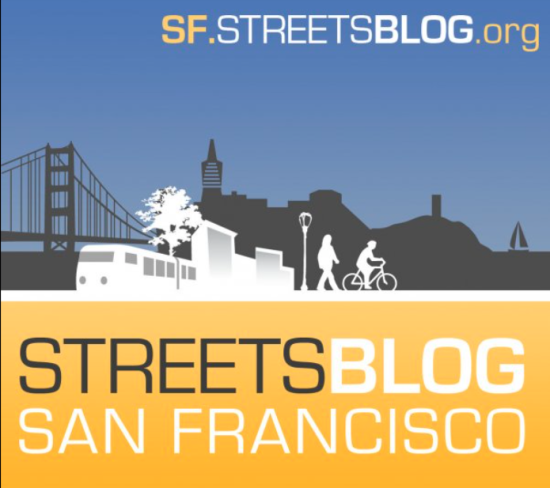 Out with the old, in with the new. Even the curbs are showing signs of the transition to more sustainable streets in San Francisco. Photo: Matthew Roth.
Out with the old, in with the new. Even the curbs are showing signs of the transition to more sustainable streets in San Francisco. Photo: Matthew Roth.Though most San Franciscans probably don't realize it, the San Francisco Municipal Transportation Agency (SFMTA) recently phased out its Department of Parking and Traffic (DPT) as part of the promise made to voters in 1999 to merge Muni with the department that managed the streets, theoretically realizing greater efficiencies for transit in the process.
The new wing of the SFMTA replacing the DPT is called the Sustainable Streets Division, and it is tasked with managing the streets to promote the city's Transit First Policy, whether that is manifest in the new protected green bike lanes on Market Street or planning for the rollout of SFPark later this summer.
"The idea is to meld all the planning into one position," said SFMTA CEO Nat Ford at a recent meeting with Streetsblog, and "not to have bike
planning, streets planning, and Muni planning separately."
To assuage any doubts, Ford pulled out his organization chart and budget documents to demonstrate the change as it relates to the agency's structure. "There is no DPT. There's not even a department to get paid out of," he said.
Ford pointed to the green bike lanes on Market Street and said the quick movement to add the lanes once the bike injunction was partially lifted was a product of the new mindset among those who manage San Francisco's streets.
"I think the whole vision of that group led them to do what they're doing
now," said Ford. "They're getting the opportunity to break out of the box they were
in as DPT. I think that's given them the courage to go out there and do
those creative things."
 San Francisco's first green bike lane is a product of shifting staff environment in the SFMTA, according to its director. Photo: Bryan Goebel.
San Francisco's first green bike lane is a product of shifting staff environment in the SFMTA, according to its director. Photo: Bryan Goebel.Another important point Ford stressed was the transition of the bicycle and pedestrian staff to more visible positions with real decision-making power, a shift that has occurred over several years. "When I first got here, DPT was still solidly DPT and Muni was still
solidly Muni," he said. "Parking and traffic was separate, planning was separate."
At the time, bicycle and pedestrian staff members were funded through grants, but weren't part of the normal SFMTA budget. "If bikes and
pedestrians are important to this operation, why aren't they part of
this budget?" asked Ford.
Many of the city's livable streets advocates were understandably happy with the change in the SFMTA and argued even the symbolic shift from a foregone parking and traffic mentality was significant.
"We've been working for more than 10 years to create a truly integrated
transportation management function in city government," said Gabriel
Metcalf, Executive Director of SPUR, a transportation think tank and one
of the primary supporters of the voter initiatives that created the SFMTA. "This is a major
step in the SFMTA becoming a truly multi-modal agency that plans for the
needs of Muni, cars, bikes, and pedestrians and makes the whole system
work."
"The demise of the parking and traffic division is good news for
those of us who think that streets are about more than just parking and
traffic, auto traffic," said Tom Radulovich, Executive Director of
Livable City and one of the pioneers of smarter parking policy in San
Francisco. "That definitely feels like progress."
Radulovich noted that Proposition A in 2007 had removed a portion
of the City Charter that mandated the city have a department of parking
and traffic. But whether this is just lipstick on a curb, according to Radulovich, is a deeper issue. "The real question is has the thinking changed."
"Certainly you can change the org chart, but if you are moving
the same people around and they have the same approach to streets and
public space, then you're going to get a lot of the same outcomes."
Ford acknowledged that they still haven't hired a permanent director of the Sustainable Streets Division, despite a nationwide search. Much of the challenge, said Ford, is due to how unique the SFMTA is as a transportation agency. In most cities, the transit operator doesn't also control planning and policy for how street space is allocated.
At present, Bond Yee, the Director of the former Department of Parking and Traffic, is acting Sustainable Streets chief. Ford said they needed to finish the arduous negotiations around the MTA budget and labor concessions before he could devote his full attention to the hiring process.
Regardless of who will eventually take the helm, Ford said his "deep pool of talented individuals" working in the division were already making a name for the SFMTA in the circles where transportation planning is meaningful.
"A lot of people talk about [NYC DOT Commissioner] Janette Sadik-Khan," said Ford, who stated that San Francisco is gaining momentum, and innovating in ways even New York City hasn't. "There's not a week our people are not being invited to come around the
world to present on what's happening in San Francisco."
 It's fitting that the SFMTA changed its curb stencils as it experiments with innovative on-street parking for bicycles. Photo: Matthew Roth.
It's fitting that the SFMTA changed its curb stencils as it experiments with innovative on-street parking for bicycles. Photo: Matthew Roth.




